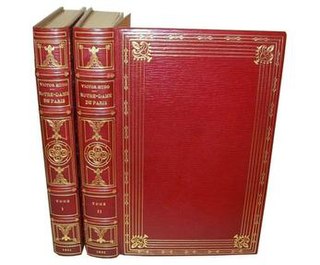
The Hunchback of Notre-Dame is a French Gothic novel by Victor Hugo, published in 1831. The title refers to the Notre-Dame Cathedral, which features prominently throughout the novel. It focuses on the unfortunate story of Quasimodo, the Roma street dancer Esmeralda and Quasimodo's guardian the Archdeacon Claude Frollo in 15th-century Paris. All its elements— the Renaissance setting, impossible love affairs and marginalized characters—make the work a model of the literary themes of Romanticism.

The Hunchback of Notre Dame is a 1996 American animated musical drama film produced by Walt Disney Feature Animation and released by Walt Disney Pictures. It is loosely based on the 1831 novel of the same name by Victor Hugo. The film was directed by Gary Trousdale and Kirk Wise and produced by Don Hahn, from a screenplay written by Tab Murphy, Irene Mecchi, Jonathan Roberts, and the writing team of Bob Tzudiker and Noni White. Featuring the voices of Tom Hulce, Demi Moore, Tony Jay, and Kevin Kline, the film follows Quasimodo, the deformed and confined bell-ringer of Notre Dame, and his yearning to explore the outside world and be accepted by society, against the wishes of his cruel, puritanical foster father Claude Frollo, who also wants to exterminate Paris' Roma population.
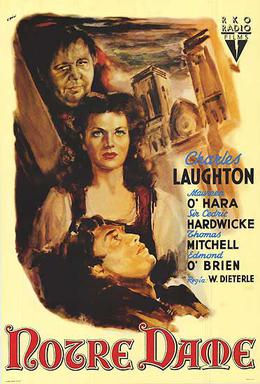
The Hunchback of Notre Dame is a 1939 American romantic drama film starring Charles Laughton and Maureen O'Hara. Directed by William Dieterle and produced by Pandro S. Berman, the film is based on Victor Hugo's 1831 novel. The film is also noted for being the first film ever shown at the Cannes Film Festival before the festival was postponed due to World War II.

Quasimodo is a fictional character and the main protagonist of the novel The Hunchback of Notre-Dame (1831) by Victor Hugo. Quasimodo was born with a hunchback and feared by the townspeople as a sort of monster, but he finds sanctuary in an unlikely love that is fulfilled only in death.
Clopin Trouillefou is a fictional character first created in the novel The Hunchback of Notre-Dame by French author Victor Hugo, and subsequently adapted.
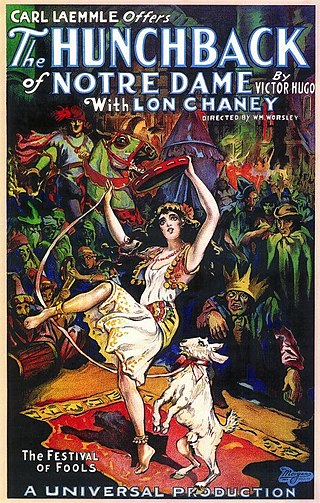
The Hunchback of Notre Dame is a 1923 American drama film starring Lon Chaney, directed by Wallace Worsley, and produced by Carl Laemmle and Irving Thalberg. The supporting cast includes Patsy Ruth Miller, Norman Kerry, Nigel de Brulier, and Brandon Hurst. Distributed by Universal Pictures, the film was the studio's "Super Jewel" of 1923 and was their most successful silent film, grossing $3.5 million. The film premiered on September 2, 1923 at the Astor Theatre in New York, New York, then went into release on September 6.
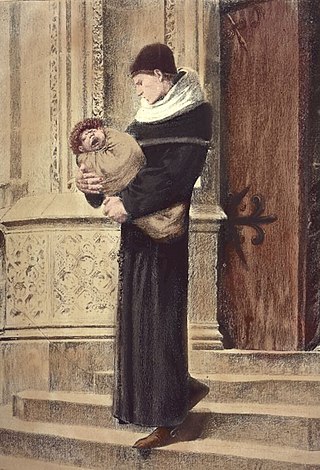
Claude Frollo is a fictional character and the main antagonist of Victor Hugo's 1831 novel The Hunchback of Notre-Dame. He is an alchemist and intellectual, as well as a Catholic clergyman.

The Hunchback of Notre Dame is a 1956 French-Italian CinemaScope film version of Victor Hugo's 1831 novel, directed by Jean Delannoy and produced by Raymond Hakim and Robert Hakim. It stars American actor Anthony Quinn and Italian actress Gina Lollobrigida. The film is the first version of the novel to be made in color.

The Hunchback of Notre Dame II is a 2002 American animated musical film directed by Bradley Raymond. It is a direct-to-video sequel to Disney's 1996 animated feature film The Hunchback of Notre Dame. The film was produced by the Japanese office of Walt Disney Animation and Walt Disney Television Animation, while it was distributed by Walt Disney Studios Home Entertainment. Much of the actors from the original film reprise their roles, with the addition of new characters played by Jennifer Love Hewitt and Haley Joel Osment. Critical reception was mostly negative.

Esmeralda, born Agnès, is a fictional character in Victor Hugo's 1831 novel The Hunchback of Notre-Dame. She is a French Roma girl. She constantly attracts men with her seductive dances, and is rarely seen without her clever goat Djali. She is around 16 years old and has a kind and generous heart.
The Magical Adventures of Quasimodo is an animated television series based on Victor Hugo's 1831 novel Notre Dame de Paris.

CapitainePhœbus de Châteaupers is a fictional character and the secondary antagonist of Victor Hugo's 1831 novel, Notre-Dame de Paris. He is the Captain of the King Louis XI's Archers. His name comes from Phoebus, the Greek god of the sun.
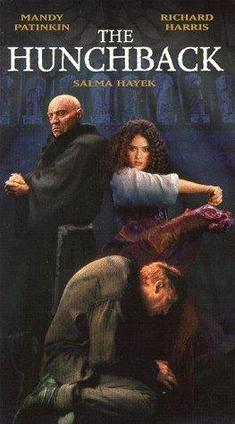
The Hunchback is a 1997 made-for-television romantic drama film based on Victor Hugo's iconic 1831 novel The Hunchback of Notre-Dame, directed by Peter Medak and produced by Stephane Reichel. It stars Richard Harris as Claude Frollo, Salma Hayek as Esmeralda and Mandy Patinkin as Quasimodo, the titular hunchback of Notre Dame.

Her Double Life is a 1916 American silent drama film directed by J. Gordon Edwards and starring Theda Bara. It is based on the Mary Murillo's story The New Magdalen, who also wrote the scenario. The film is now considered lost.

The Vixen is a 1916 American silent drama film directed by J. Gordon Edwards and starring Theda Bara. This film was also titled The Love Pirate in the UK, and Il Pirata Dell'Amore in Italy. The film is now considered a lost film.

The Tiger Woman is a 1917 American silent drama film directed by J. Gordon Edwards and George Bellamy and starring Theda Bara. The film is now considered lost.

The Hunchback of Notre Dame was a 1911 French silent film directed by Albert Capellani and produced by Pathé Frères. It was released under the name Notre-Dame de Paris. It starred Henry Krauss and Stacia Napierkowska. The film was based on the 1831 Victor Hugo novel of the same name. Considering the film's brief running time, critic Christopher Workman considered it "remarkably faithful to its source material" but it "contains no discernible humor, unlike most other horror films of the period, and thus represents a bellwether of sorts for the genre....(Henry Krauss as Quasimodo) "looks remarkably like Charles Ogle in (Thomas) Edison's 1910 Frankenstein."
The Hunchback of Notre Dame is a British feature length adaptation of the 1831 novel by Victor Hugo, produced for television by the BBC in 1976 and aired on December 30 the same year. Directed by Alan Cooke and written by Robert Muller, the film stars Kenneth Haigh as Claude Frollo, Warren Clarke as Quasimodo and Michelle Newell as Esmeralda, and features the visual effects by Ian Scoones and the original music by Wilfred Josephs.
The Hunchback of Notre Dame is a 1986 Australian/American fantasy animated film and an adaptation of the 1831 novel of the same name by Victor Hugo.
"God Help the Outcasts" is a song written by composer Alan Menken and lyricist Stephen Schwartz for Walt Disney Pictures' animated film The Hunchback of Notre Dame (1996). A pop ballad, the song is performed by American singer Heidi Mollenhauer as the singing voice of Esmeralda on American actress Demi Moore's behalf, who provides the character's speaking voice. A prayer, "God Help the Outcasts" is a somber hymn in which a beset Esmeralda asks God to shield outcasts and Roma like herself against racism and discrimination at the hands of Paris and Judge Claude Frollo. The song also establishes Esmeralda as a selfless, empathetic character with whom Quasimodo falls in love.















